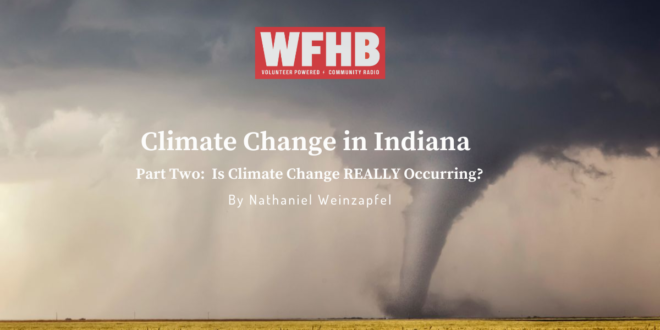Podcast: Play in new window | Download (Duration: 11:24 — 10.5MB)
Subscribe: RSS
By Nathaniel Weinzapfel
Introduction:
First held in 1970 and recently reaching its 50th year anniversary, Earth Day is an annual holiday held to demonstrate support for environmental protection and celebrate life on our planet, with over a billion people participating in related events worldwide. This holiday has been extended to encompass all of April, in what has been aptly named Earth Month. In celebration of Earth Month there have been a series of news stories that began last week focusing on how Indiana is likely to be affected by climate change. Researchers have rigorously studied what Indiana’s future will entail, and these stories will cover the likely outcomes and provide some specific context. This is the second episode of the series, with this one being based around another discussion with Professor Ben Kravitz, a climate scientist and assistant professor at Indiana University, who helps explain why we know climate change is occurring that will allow us to explain specifically the relationship between climate change and Indiana.
NBC News Report Segment:
From horrific tornado damage…
“It just looked like a battlezone”
…to historic flooding…
“You couldn’t see anything but water. nothing but water”
…and raging wildfires…
“Got everybody out. But it’s heartbreaking”
The UN’s latest most in depth scientific report on climate change warns the dangers are immediate and growing more acute.
History of Climate Science:
Climate science and the general knowledge we have about climate change didn’t begin with the United Nations’ Intergovernmental Panel on Climate Change. The history of the scientific field goes back about two centuries ago, when French physicist Joseph Fourier first proposed the idea that Earth’s atmosphere acted as a greenhouse, and allowed the planet to remain consistently warm. Irish scientist John Tydall would later begin to determine what the composition of the greenhouse was through laboratory experiments in the 1860s. These tests found that compounds related to coal, including carbon dioxide and methane, were excellent sources to absorb energy from the sun. Three decades later Svante Arrhenius discovered that the decreases and increases in global CO2 levels could cool and warm the planet respectively. However, the connection between these discoveries and the growth of the industrial world was not made until the 1930s when British engineer Guy Stewart Callendar realized that average temperatures in the United States had warmed since the industrial revolution, and that the Earth as a whole is likely warming.
Modern climate science has its origins in the founding of the Mauna Loa Observatory in Hawaii which began to record atmospheric CO2 levels consistently since 1958. The information gathered at the observatory is depicted in the most famous of climate diagrams, showing CO2 levels rising every year since the record began. This is called the Keeling Curve.

Professor Kravitz & Climate Modeling:
The Kneeling Curve and the climate models that followed all sought to understand the relationship between global average temperature and the different impacts humans have on the global climate. Professor Kravitz knows this topic all too well. His 15 year career began by solely focusing on math, before becoming interested in atmospheric science and how equations can be used to predict weather and understand climate change. The professor explains exactly what his area of focus is when it comes to climate change.
“I tend to be really interested in the physical climate. So basically, the way I describe it is when you push the Earth system, how does it respond? We call that radiative forcing and climate response. I’m interested in feedbacks. I’m interested in exploring the Earth as a system and how we can get strange responses when we do things that seem like they wouldn’t elicit strange responses. And just sort of poking around and trying to figure out how the Earth system works. I tend to do a lot of this work with climate models, because it’s a really great laboratory where you can do strange things to the Earth system and not actually mess anything up.”
In fact, climate modeling can be a useful tool to test numerous theories about climate change. Some models allow the forcings (otherwise known as impacts) of aerosols to be adjusted, along with land-use change, surface albedo (or the reflectivity of the surface of the planet), and greenhouse gas emissions. For example, aerosols, when increased, are shown to cool the Earth, while a decrease in surface albedo is shown to warm the planet. Professor Kravitz explains how scientists know that climate change is occurring through the consolidation of numerous historical data points as well as how we know that humans are definitively causing the change.
“So we have observations that the climate is changing. So we have observations from space satellites, from the ground thermometers everywhere, we’ve had a good thermometer network since the late 1800s. We also have climate models, which are basically our best understanding of how the Earth Systems physics work. And we can plug things in, like if we plug in greenhouse gasses, the temperature goes up. And we know why. Because we can pick apart the different pieces of the model that are contributing to that. So we can plug in, alright, what has historical emissions done, let’s plug that into the model, the temperature goes up. If you don’t have historical greenhouse gas emissions, the temperature doesn’t go up. So we have a bunch of different ways in which we understand climate change. And that’s just temperature. We also know that as temperature goes up, the atmosphere can hold more water, and it’ll change rain patterns, and we can see those in observations and models. We know that as temperature goes up, sea ice will melt and we can see that in observations and models. So there are many many different points of evidence all building to the same conclusion.”
It is this conclusion that led to the United Nations founding the Intergovernmental Panel on Climate Change, otherwise known as the IPCC, in 1989, which hoped to explain the scientific view of climate change to the citizens of the world and detail the potential political and economic impacts. The Panel releases Assessment Reports every six to seven years, with the sixth assessment report releasing this previous February. The creation of the IPCC inspired many governments worldwide to act. First, the Kyoto Protocol was established and hoped to reduce greenhouse gas emissions by 5.2 percent by 2008. However, the United States pulled out of the agreement. Once again, in 2015 the world agreed to the Paris Climate Agreement, but the United States left the agreement and only just joined again with the new presidential administration.

This may be the push and pull of politics, but time is running out. According to the 2019 Climate Action Summit, the temperature of “1.5℃ is the socially, economically, politically and scientifically safe limit to global warming by the end of this century, and to achieve this, the world needs to work to achieve net zero emissions by 2050” It seems that the world may be running out of time.
Climate Denialism:
With almost two centuries of supportive data, an overwhelming endorsement by the scientific community, and the already visible effects of climate change, why are there still so many people who are unwilling to act? Professor Kravitz explains why people may choose to ignore the science.
“You’d have to ask them! My personal perspective is that when I see all of this evidence, I understand that it’s all pointing toward the same conclusion. There are other people who either cannot or choose not to do that and I’m sure they have a good reason for it. But that’s inconsistent with what the science says.”
This extends even to our state of Indiana. The state government has taken stances that effectively harms the efforts of environmentalists to stop pollution and hopefully curb climate change. For example, last summer Governor Eric Holcomb signed House Bill 1191 into law which removed the powers of local governments to enact energy regulations and prevent fossil fuel usage. Even individual policymakers have made comments that seemingly dispel the seriousness of the issue. Indiana’s Republican Senator Todd Young once denied the consensus on climate change when he was Representative for 9th district, stating that:
“We’re often told that there is a consensus among scientists. I’ve come to discover that through the number of scientists I’ve talked to this is not necessarily the case.”
Despite the opinion of Senator Young, there is a consensus on climate change. When asked whether most climate skeptics are simply uninformed or are purposefully nefarious, Professor Kravitz had this to say:
“In my experience, I don’t think either one is the case. So I see very few people out there who are just straight up lying. Like they look at the evidence and say, I’m going to lie about it. For people who are steadfast climate contrarians, giving them more information doesn’t help, because they will reject the new information because it conflicts with their values. And so what I think is going on is that there are people out there who ascribe to a particular worldview and climate change does not fit in their worldview. So they reject the evidence for it, and you see that sort of thing all the time and for other issues. This is basic human nature. But it’s important that we know that’s what’s going on, because there are people out there who are working on communication, and building trust, so that we can hopefully get everybody on board with trying to solve this problem.”
Do you believe climate change has been communicated poorly?
“Historically, yeah, I do. Because climate change communication was basically left up to the scientists. And scientists are not necessarily great communicators, some of them are. Some of them are not. I didn’t get into this business because I wanted to be a communicator, I got into this business because I like doing science and I like computers. And I like running climate models. Communication is a skill that I just haven’t spent a lot of time on.”
Efforts are being made to better communicate the topic of climate change. One such method is through appealing to one’s metaphorical backyard, such as through a series of radio segments about the topic. How climate change will impact Southern Indiana and the rest of the state is an effective tool to help convey the reasons why sustainable and achievable adjustments should be made to switch to more renewable energy and be more environmentally friendly.
Tomorrow, join us as we discuss how the increasing temperatures associated with climate change will impact the agricultural sector of the state of Indiana.
 WFHB Bloomington Community Radio
WFHB Bloomington Community Radio


